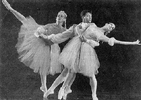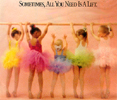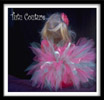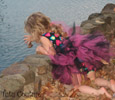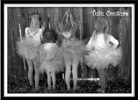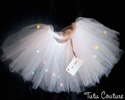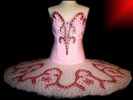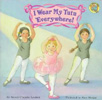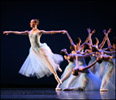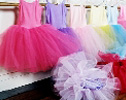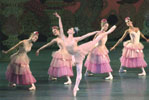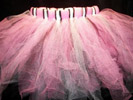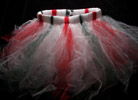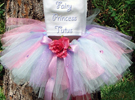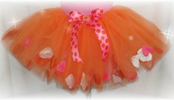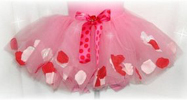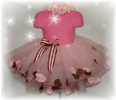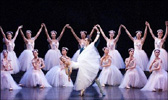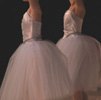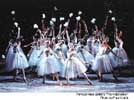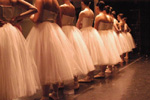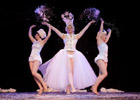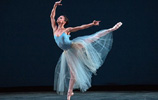

Dance WearLinks of interest:
Click on a picture for a larger view..
www.tutupattern.com
In Retrospect To The Ballet Tutus Of Today
As the dance became more and more renowned in the whole world, two types of balled tutus also emerged. First is the long romantic version or Juliet style ballet tutu and the short provocative version or Classic style ballet tutu.
The Juliet style ballet tutus are often attributed to the famous brilliant ballerina from Sweden, Marie Taglioni. In the 1800’s, she was known to be the first to dance “en pointe” (on her tiptoes in ballet slippers).
The ballet tutus she wore were usually cut to below the knee to unveil the intricacies of her famous legwork. Those romantic ballet tutus were delicate, feminine and made of material.
It allowed Taglioni to move about freely floating through the air and executing the precise movements that gave her cult status. As the dance moved on to the pinnacle of its esteem, more connoisseurs of the art form demanded to see the complex movements that the dancers performed.
It was then that the ballet tutus shrank. The style of ballet tutus commonly referred to as Classic is a short, stiff skirt that juts out horizontally from a ballerina’s hipbones exposing her legs entirely.
This kind of ballet tutu is often worn with a leotard, which hugs the dancers’ body.
Today, ballet tutus are designed to allow dancers an ethereal, airy, feminine appearance.
In most cases, it gives the purpose for one to move about fluidly while permitting the audience to view her elaborate gestures and complicated foot works. The skirt of which is typically made from a material called tulle and the pattern depends whether is it romantic or classic.
Ballet tutus are composed of three parts namely bodice, basque and skirt. The bodice is a piece that is designed similar to a corset. It is meant to hug those bodies while staying in place through the rigors of a dancer’s movements.
The Basque is the one that attaches the bodice to the skirt which gives the costume a unique structure. The skirt is either long and flowing if it is of romantic style or short and jutting if it is of classic style.
Up to now, you may still be wondering where “tutu” originated. Its origin is not as elegant and beautiful as the garment itself. Legend has it that the term stemmed from a slang word used by commoners who just sit on the floor as they watch a performance on stage.
They use “tutu” as the word to describe what they have seen. Meaning, they often get more out of the actual show than what they have bargained for. Even if designers have eventually figured out a way to eliminate the embarrassing costume problem, the name “tutu” stuck.
As posted at www.lfieinfozone.com on Oct. 8, 2007
What Is A Ballet Tutu?
Are you familiar with ballet tutu? Your answer is probably “Yes” as ballet tutu is what most ballerinas often wear during their performances. It refers actually to the ballooning skirt worn by the ballet dancers.
As commonly defined, the ballet tutu is a skirt worn as a costume by dancers in ballet performance. It is worn often with a bodice attached to it.
Well, ballet tutu designers have said that this garment may differ according to its layer.
This is for the reason that a ballet tutu might be single layer, double layer, or with three or more layers.
Also, it may differ according to its style as some of the ballet tutus appear to be hanging down, while there are some that feature multiple layers that are starched or strutted out.
The ballet tutus are worn by way of wrapping them around the skirts. Once wrapped, the tutu is fastened in the waist often by the use of ribbon which is usually sewn in its waist. There are also some instances that ballet tutus are attached to the dancers’ leotards that are normally long armed.
There are different kinds of tutu. These types were identified mainly by their style as well as by the time they were introduced. Included in the list of the most recognized ballet tutu types are the following:
Balanchine or Karinska Tutu –
This type tends to appear as similar to the bell and powder puff-plate tutu. Perhaps the main difference between the two is that in this kind, no hoops are used and only fewer layers of netting are considered.
Aside from that, the Balanchine or karinska tutu is tacked loosely for one particular purpose – to give it a softer and fuller aura.
Romantic Tutu –
This is the ballet tutu type that is particularly known for its having a three quarter length bell shape. Most of the tutu designers craft this ballet tutu from tulle featuring a fitted bodice and cap sleeves.
Also, according to some reviews, the romantic tutu is free flowing, giving a sense of ethereal quality and lightness to the romantic ballets, to which it is often used.
Classical Bell Tutu –
This type is commonly identified as being short and stiff tulle skirt that presents a slight bell shape and a fitted bodice. Most of the classical bell tutus use a wired hoop, and they often appear to extend outwards from the hips.
Classical Plate Tutu –
This is finally the fourth known type of ballet tutu. Well, just like the classical bell tutu, this type is short and stiff tulle skirt that extends outwards from the hip. It also has a fitted bodice like the former type.
But, the difference between the two appears as the classic plate type usually feature a pancake design with wires spokes rather than a powder puff designused in the classical bell tutu. These spokes are used mainly to keep the material stiff.
So you've learned the types. Now is the time for you to know that ballet tutus should be carefully chosen. It should fit the body well, allowing you to move with ease. Never choose ballet tutus that are too loose as they can make you fumble onstage.
As posted on www.lifeinfozone.com on Oct. 8, 2007

